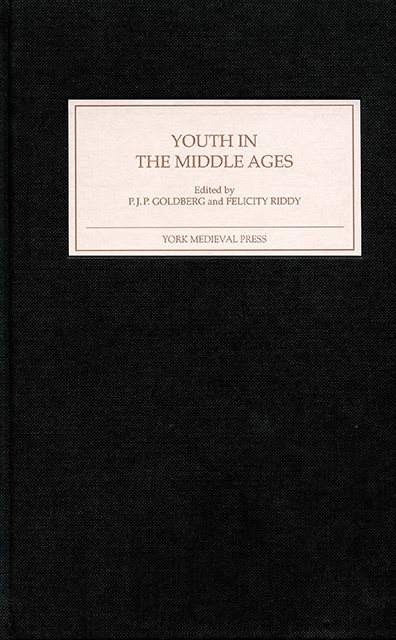Book contents
- Frontmatter
- Contents
- List of Contributors
- Introduction: After Ariès
- Childhood and Youth in the Early Middle Ages
- Jewish Society under Pressure: The Concept of Childhood
- Desiring Virgins: Maidens, Martyrs and Femininity in Late Medieval England
- Out of the Mouths of Babes: Authority in Pearl and in Narratives of the Child King Richard
- A Safe-Haven for Children? The Early Humiliati and Provision for Children
- Migration, Youth and Gender in Later Medieval England
- Good Advice on Leaving Home in the Romances
- ‘Youth on the Prow’: Three Young Kings in the Late Viking Age
- Index
- York Medieval Press: Publications
Migration, Youth and Gender in Later Medieval England
Published online by Cambridge University Press: 25 March 2023
- Frontmatter
- Contents
- List of Contributors
- Introduction: After Ariès
- Childhood and Youth in the Early Middle Ages
- Jewish Society under Pressure: The Concept of Childhood
- Desiring Virgins: Maidens, Martyrs and Femininity in Late Medieval England
- Out of the Mouths of Babes: Authority in Pearl and in Narratives of the Child King Richard
- A Safe-Haven for Children? The Early Humiliati and Provision for Children
- Migration, Youth and Gender in Later Medieval England
- Good Advice on Leaving Home in the Romances
- ‘Youth on the Prow’: Three Young Kings in the Late Viking Age
- Index
- York Medieval Press: Publications
Summary
In 1301 a series of ordinances was issued for York which was designed to regulate trade in response to the difficulties caused by the residence of the royal court within the city. One of the more remarkable of these was that baldly entitled ‘pigs and prostitutes’. The juxtaposition is a very telling one. Not only were pigs symbolic of lust, but they created problems by wandering the streets. So did prostitutes, whose feet, like the archetypal harlot of the book of Proverbs, ‘will not abide within the house’. Thus when the mother in The Good WyfeWold a Pylgremage warned her daughter, ‘rene thou not fro hous to house lyke an Antyny gryce’ [piglet], she was intimating that such behaviour implied a lack of chastity. Clearly within clerical, didactic and civic governmental sources women’s mobility was frowned upon. Here we may note that only two of Chaucer’s pilgrims were female, the Prioress and, more significantly, that singular creation of anti-feminist discourse, the Wife of Bath. The movement of women may have been regarded as in some way particularly subversive, but the labour legislation of the later fourteenth century warns us that all migration was seen in some quarters to be subversive. The Commons’ petition against vagrants of 1376, for example, saw in the mobility of labourers ‘the great impoverishment, destruction and ruin of the commons’ and hinted darkly that such migrants often became ‘staff strikers’ (clearly the medieval equivalent of New Age travellers) who ‘lead an idle life, commonly robbing poor people in simple villages’. But neither the petition against vagrants nor Chaucer’s fictional pilgrims are simple mirrors of society. Any perusal of conventional historical sources reveals that medieval men and women were both highly mobile and that such mobility played an essential part of the functioning of a complex society. The purpose of this paper is to try to reconcile these two perspectives.
There is a wealth of evidence to indicate that medieval society was highly mobile and that significant numbers of people would have moved from their natal homes during the course of their lives.
- Type
- Chapter
- Information
- Youth in the Middle Ages , pp. 85 - 100Publisher: Boydell & BrewerPrint publication year: 2002
- 1
- Cited by

